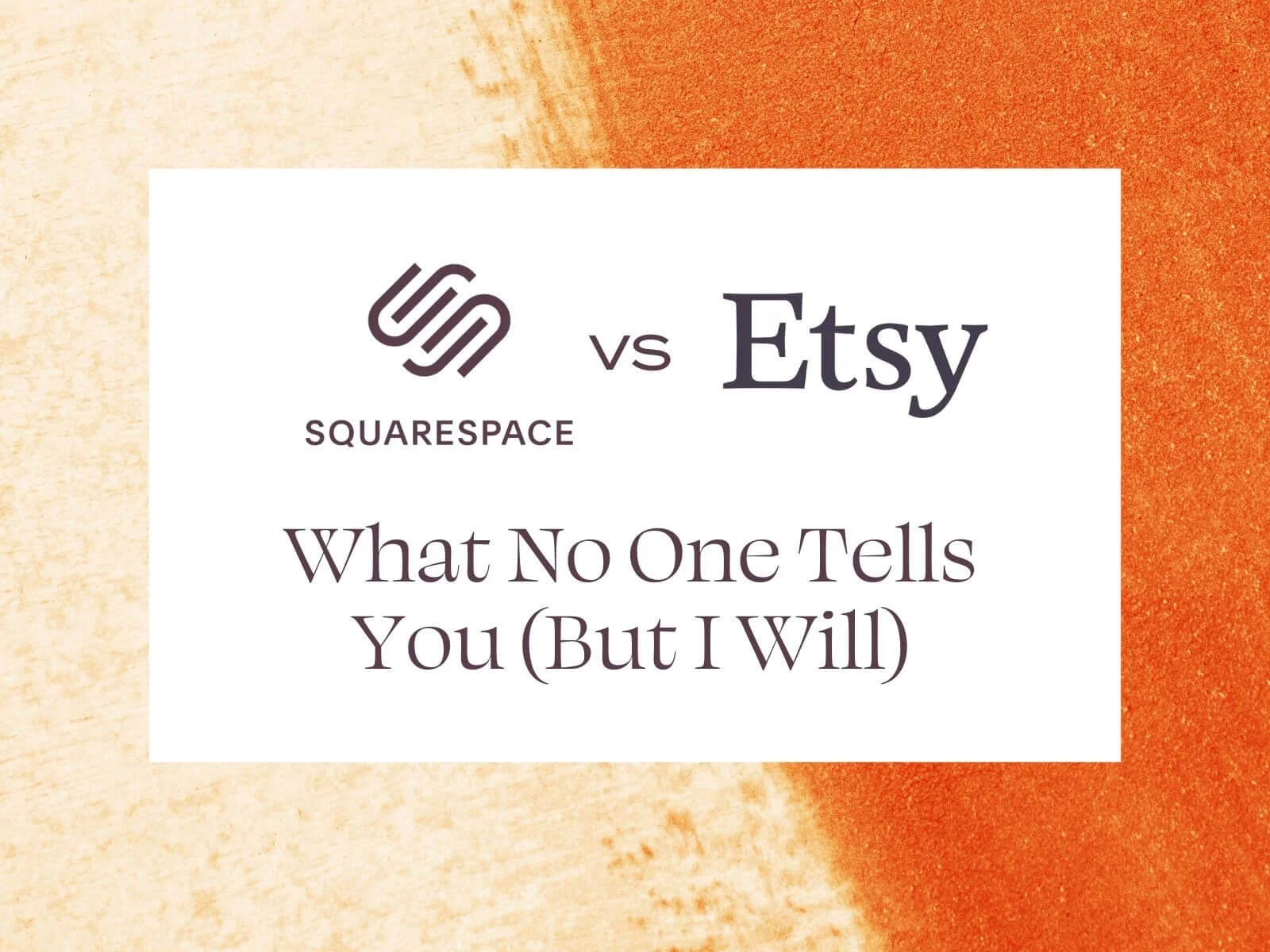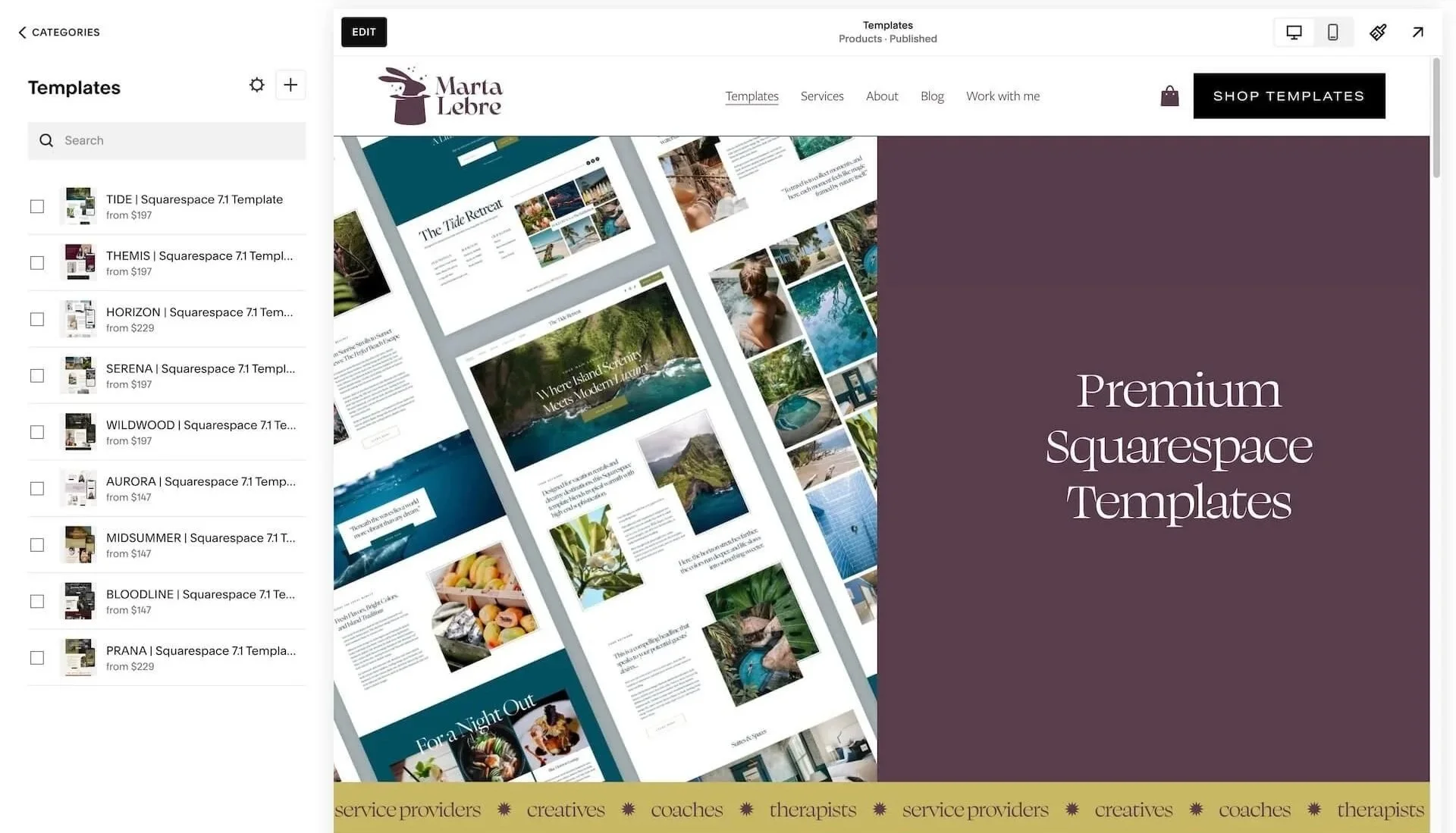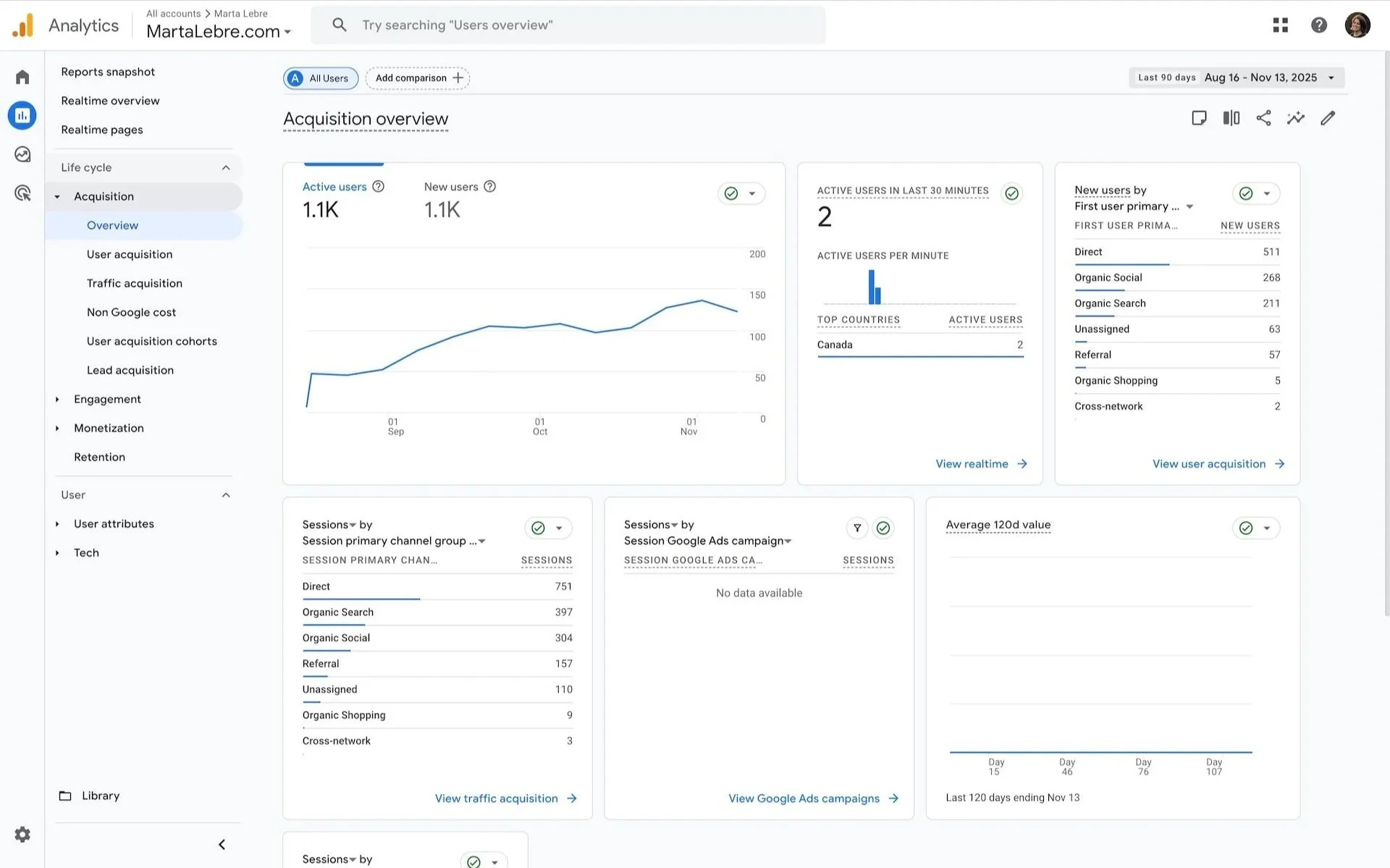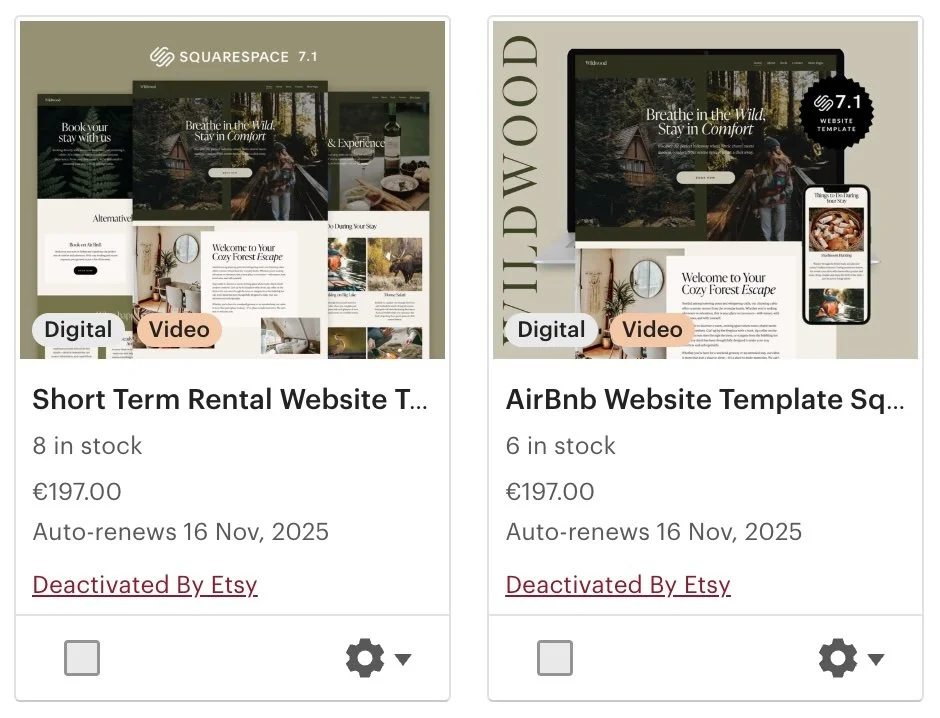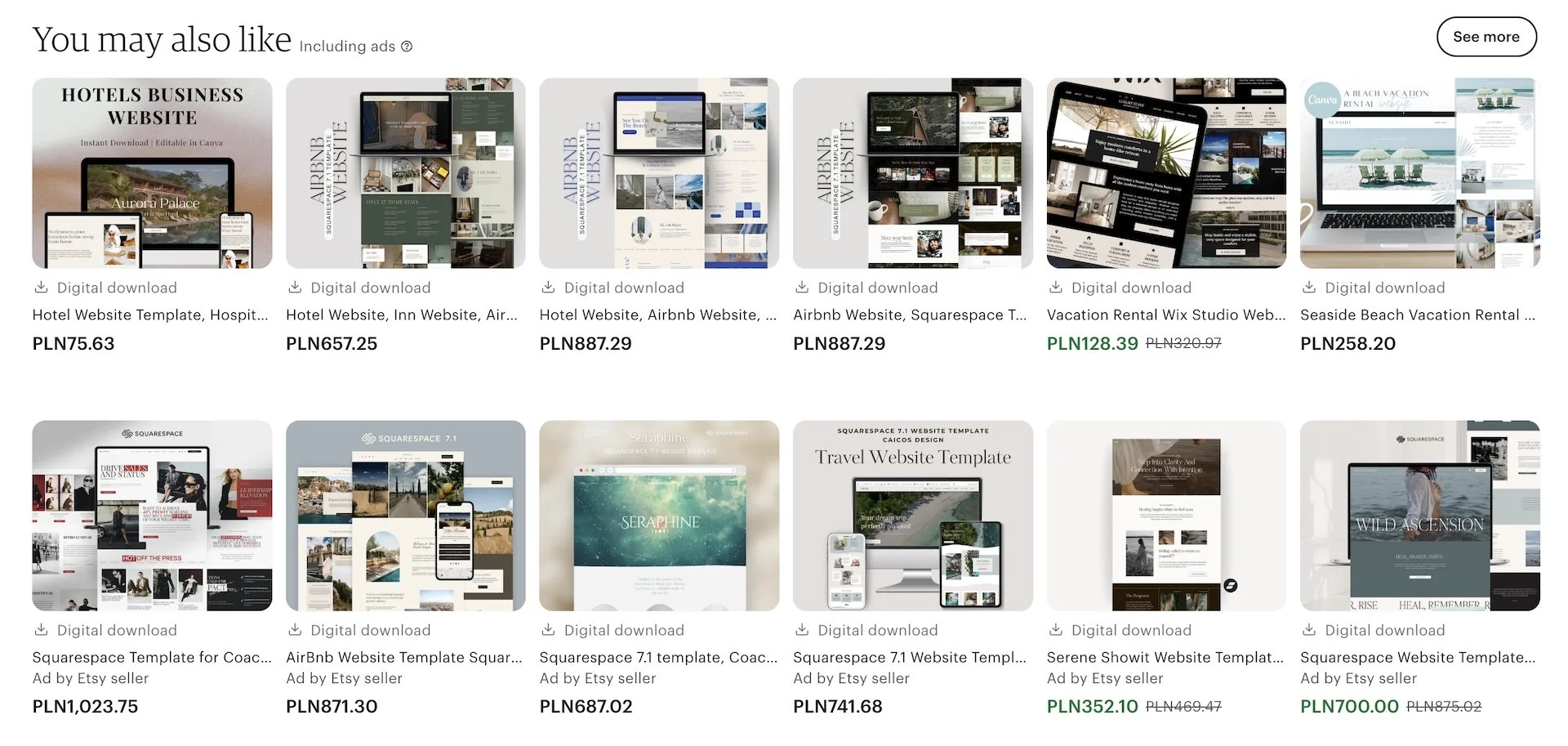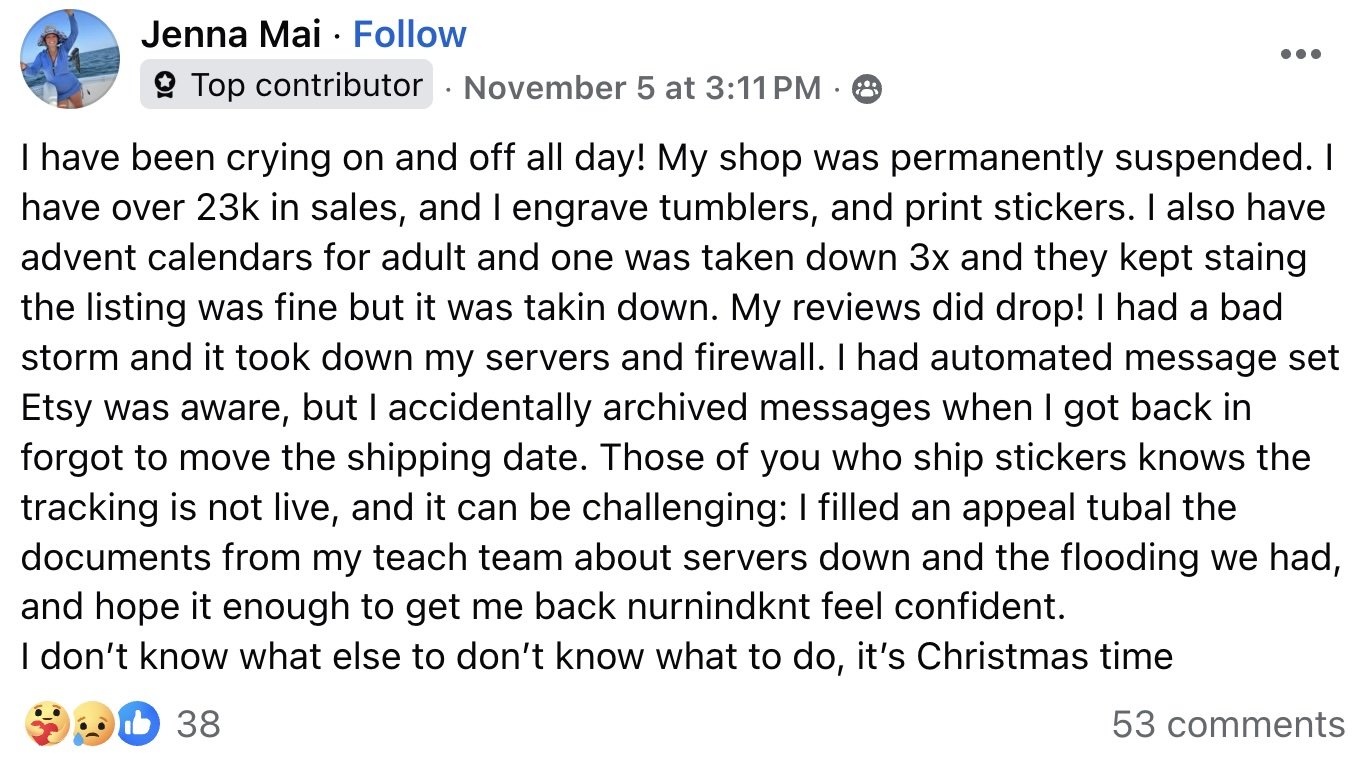Squarespace vs Etsy (2025): What No One Tells You (But I Will)
Squarespace vs Etsy is ultimately a question of borrowed visibility versus owned stability — and this guide shows exactly which platform serves your business long-term.
Before I ever became a Squarespace designer, I was deep in the Etsy trenches. I’ve had more Etsy shops than I can count — print-on-demand, digital downloads, one-of-a-kind logo designs. I still sell there my Squarespace Templates.
I’ve run Etsy Ads, survived fee increases, dealt with copyright bots, got hacked, and yes… I’ve had listings flagged by competitors simply because they were selling too well. (My Wildwood template? Gone overnight.)
I was tired of high fees, the unpredictable algorithm, and the constant fear of their shop being suspended without warning. Etsy can be magical for traffic — but it can also feel like building your business on someone else’s land, under someone else’s rules, with someone else’s finger hovering over the “suspend shop” button.
Squarespace, on the other hand, is the opposite.
It’s slower at the start — you have to do your SEO, your marketing, your Pinterest strategy. But it’s yours. Your brand. Your customers. Your margins. No one can shut it down because a bot thought your product “looked similar” to someone else’s. It’s safer, more scalable, and much more profitable long-term.
And here’s the truth most creators don’t realize:
It’s not “Squarespace vs Etsy.” The smartest sellers use both.
Etsy gives you visibility.
Squarespace gives you stability, consistency, and brand power.
This guide will walk you through exactly what each platform does well, what each platform will never give you, and how to choose the right setup based on where you are in your business — whether you’re selling candles, digital files, jewelry, templates, art prints, or ceramics.
Let’s get into the real comparison (no fluff, no bias — just lived experience and hard data).
Table of Contents
TL;DR - Squarespace vs Etsy
If you’re overwhelmed by the details, here’s the TL;DR: Squarespace is the platform you own; Etsy is the platform you borrow. Squarespace gives you full control over your branding, your product presentation, your customer list, and your profit margins. You pay one flat monthly fee, and that’s it — no listing fees, no surprise offsite ads charges, no 6.5% transaction fees cutting into your revenue. It’s stable, predictable, and designed for long-term growth through SEO, Pinterest, blogging, and returning customers.
Etsy is the opposite: fast visibility, low barrier to entry, and massive built-in traffic — but at the cost of high fees, algorithm dependence, limited branding, and the risk of sudden takedowns or competitor reports. It’s incredible for being found, but not ideal for building a stable, scalable business. The table summarizes it clearly: Etsy is your traffic engine; Squarespace is your brand home.
The smartest sellers use both — Etsy for discovery and Squarespace for control, consistency, and long-term profit.
| Feature | Squarespace | Etsy |
|---|---|---|
| Ownership | ✔ You own your site, brand, & customer list | ❌ Marketplace owns the platform & controls access |
| Traffic | ❗ Requires SEO, Pinterest, email marketing to grow | ✔ Built-in traffic + high buyer intent |
| Fees | ✔ Flat monthly fee ✔ No listing fees ✔ No offsite ads fees ✔ Zero transaction fees (Commerce plans) |
❌ Listing fees ❌ 6.5% transaction fees ❌ Payment fees ❌ 12–15% offsite ads ❌ Etsy Ads costs |
| Branding | ✔ Full design control ✔ Custom pages, fonts, layouts ✔ Unique brand experience |
❌ Template-heavy, limited layout ❌ Shoppers remember Etsy, not the seller |
| SEO | ✔ Full control over SEO, URLs, content, blog ✔ Long-term Google visibility |
✔ Etsy listings rank on Google ❗ But buyers see competitor listings immediately |
| Stability & Safety | ✔ Stable platform ✔ No random shutdowns ✔ No competitor reports |
❗ Shops can be flagged or suspended ❗ Competitor reporting is common ❗ Algorithm changes affect visibility |
| Product Freedom | ✔ Sell anything (physical, digital, services, courses, subscriptions) | ❗ Strict rules ❗ Copyright bots ❗ Limited categories ❗ Products often get flagged |
| Profitability | ✔ High margins ✔ No % fees on sales ✔ No ads required |
❌ High fees reduce margins ❌ Ads often necessary to stay visible |
| Best For |
• Building a brand • Stable long-term business • Selling digital & physical products with high margins • Creatives wanting full control |
• New sellers looking for fast visibility • Testing product ideas • Marketplace-driven impulse purchases • Low-barrier shop setup |
What Etsy Actually Is (and What It Isn’t)
Etsy isn’t a website builder or a shop platform — it’s a marketplace. Think of it like renting a tiny stall in a giant, extremely crowded shopping mall. You get traffic, you get visibility, and you get access to millions of people who are already in “I’m ready to buy something cute” mode. That’s Etsy’s real power. They bring the customers to you.
But because Etsy is a marketplace, not your own website, everything you do happens inside their ecosystem, under their rules. You don’t own the land — you rent a space on it.
Here’s what that really means in practice:
Etsy controls the search algorithm — they decide who gets seen and who gets buried.
Etsy controls the customer relationship — the customer belongs to Etsy, not you.
Etsy controls your visibility — sellers depend heavily on Etsy Ads and Offsite Ads for any meaningful traffic.
Etsy controls your margins — fees stack up fast (listing fees, transaction fees, payment fees, ads, and offsite ads).
Etsy controls your shop’s fate — a single bot-triggered copyright flag or a competitor report can suspend your listings or your entire shop.
Etsy controls the branding — every shop looks more or less the same and sits inside Etsy’s visual format.
Etsy is a crowded marketplace — you’re competing directly with thousands of similar shops, often on price.
Etsy is incredible for discoverability.
But it’s terrible for control.
If you’re brand new or want quick traffic, Etsy is a fantastic place to start. It’s low-barrier, fast to set up, and full of high-intent buyers. But if you want a long-term business, brand trust, or stable profits, you eventually outgrow the limitations — especially the fees and the risk of sudden suspensions.
The most successful sellers understand this:
Etsy is borrowed land. It’s powerful, but it’s not home.
My Etsy shop
What Squarespace Actually Is (and What It Isn’t)
Squarespace isn’t a marketplace — it’s your own website, on your own domain, with your own brand identity, customer experience, and control. If Etsy is a rented stall in a crowded mall, Squarespace is owning your own boutique on a street where you decide the layout, the vibe, and the customer journey.
Squarespace gives you a fully hosted, all-in-one platform to build a professional website without touching code (unless you want to). It handles the hosting, security, updates, eCommerce tools, blog, templates, image optimization, analytics, paid memberships, courses, and checkout — all under one login. You’re not piecing together plugins or worrying about whether your website will break during an update. It’s stable, protected, and predictable.
What this really means for sellers:
You own your brand — the domain, the design, the messaging, the customer experience.
You own your traffic — SEO, Pinterest, blog content, repeat customers, email list.
You own your margins — no listing fees, no 6.5% transaction fees, no offsite ads.
You own your customer relationship — emails, subscribers, abandoned carts, loyalty.
You control your pricing — no forced promotions or race-to-the-bottom discounts.
You control your product rules — no random flags, no “similar to another listing” takedowns.
You can build a real brand — with custom pages, storytelling, galleries, video, blog, SEO, and full design freedom.
Your site can’t be shut down randomly — you’re not living at the mercy of bots or competitor reports.
Squarespace won’t hand you instant traffic the way Etsy can — you have to build it with SEO, Pinterest, email, and smart marketing. But the traffic you do build is yours forever. And the brand you create becomes an asset that grows in value instead of disappearing if a marketplace decides to flag you.
In simple terms:
Etsy helps you get found. Squarespace helps you get remembered.
My Squarespace shop
Etsy Fees vs Squarespace Costs (the Surprising Math)
Most people look at Squarespace’s monthly price and think, “Wow… that’s expensive compared to Etsy’s free-to-open shop.”
But that’s not the real math. Once you break down Etsy’s fee structure, Squarespace ends up being dramatically cheaper for most sellers — especially physical product sellers and anyone running Etsy Ads.
Let’s look at what Etsy actually charges you every time you make a sale.
Etsy Fees (2025)
1️⃣ Listing Fee: $0.20 per listing, paid whether the item sells or not, renewed every time a product sells out.
2️⃣ Transaction Fee: 6.5% of the entire order total (including shipping + gift wrapping + production costs)
3️⃣ Payment Processing Fee: Around 3% + $0.25 (varies by region)
4️⃣ Offsite Ads Fee: Etsy automatically advertises your listings online. You pay ONLY when someone buys through that ad, 12–15% of the order value. You cannot opt out if you made $10k+ in the last rolling year. Many sellers don’t realize this until it hits their income.
5️⃣ Etsy Ads (optional but almost necessary): You set a daily budget (most sellers spend $3–$10/day). How much you pay will depend on the competition, and it’s highly competitive. Often low return unless you aggressively optimize listings. You pay for clicks, whether the product sells or not.
6️⃣ Currency conversion, regulatory fees, refunds, etc. These vary, but they add up quickly.
What this looks like in real numbers
Let’s say you sell a $40 product:
$40 × 6.5% transaction fee = $2.60
Payment processing = $1.45
Listing fee = $0.20
If sold via Etsy offsite ad (very common): $40 × 12% = $4.80
Total fees:
👉 $9.05 on a $40 sale
👉 ~22% of your revenue disappears
And that’s before paying for Etsy Ads, materials, packaging, or your time.
For physical product sellers?
It’s brutal.
For digital sellers?
Still painful.
Squarespace eCommerce costs (2025)
Squarespace runs on a simple flat monthly fee, and that alone makes it dramatically more affordable than Etsy for most sellers. With Squarespace Commerce, you get zero transaction fees, no listing renewal fees, no offsite ads charges, and you don’t have to pay for Etsy Ads just to stay visible. You can upload unlimited products, make unlimited sales, and your margins stay exactly where you set them — instead of watching 20–25% disappear into marketplace fees. The entire platform is built to scale without punishing you for growing. Whether you sell 2 items or 2,000, your cost stays the same every month, which is why so many Etsy sellers eventually move their main shop to Squarespace.
| Feature | Personal | Business | Commerce Basic | Commerce Advanced |
|---|---|---|---|---|
| Price (2025) | US $16/month (annual) |
US $23/month (annual) |
US $36/month (annual) |
US $49/month (annual) |
| eCommerce Features | ❌ No product sales | ✔ Sell products 3% transaction fee |
✔ Full store 0% transaction fee ❌ No subscriptions |
✔ Full store 0% transaction fee ✔ Subscriptions |
| Advanced Selling Tools | ❌ None | ⚠️ Limited | ❌ No advanced shipping ❌ No abandoned cart |
✔ Advanced shipping ✔ Abandoned cart ✔ Complex discounts |
| Best For |
Portfolio sites Blogs Service websites |
Service providers Small shops Light eCommerce |
eCommerce brands Physical products Digital products |
High-volume shops Subscriptions Scaling businesses |
If you:
make more than 10–15 sales per month, OR
sell anything over $25, OR
do even a small amount of Etsy Ads…
Squarespace becomes cheaper than Etsy.
Often dramatically cheaper.
BUT — Etsy still has one undeniable advantage…
Traffic.
This is why the smartest sellers use:
Etsy → to GET visibility
Squarespace → to KEEP customers and profits
You let Etsy bring people in, and you let Squarespace turn them into fans who buy again — without giving 20–25% to a marketplace.
Squarespace vs Etsy: Traffic
One of the biggest differences between Etsy and Squarespace is how traffic works. Etsy is a marketplace with millions of shoppers already browsing, searching, and ready to buy (390—400m a month!). When you list a product there, you’re essentially putting it in front of a stream of people who didn’t even know your brand existed ten seconds ago. That’s Etsy’s biggest advantage: built-in traffic. Even with rising competition and algorithm changes, Etsy still delivers visibility that beginners could never generate on their own overnight.
Squarespace is the complete opposite. You have to build your own audience from scratch.Traffic comes from SEO, Pinterest, blogging, email marketing, social media, and brand reputation. It’s slower at first because you’re planting seeds instead of renting visibility. But once those seeds grow, the traffic is yours forever. Your blog posts rank for years, your Pinterest pins keep circulating, your email list grows, and your repeat customers return directly to your site.
Etsy gives you instant exposure but zero ownership.
Squarespace gives you long-term ownership, but you need to earn the exposure.
The magic happens when you combine them: let Etsy bring buyers in, then guide them toward your website where you control the relationship, the margins, and the lifetime value. This is how sellers stop being “just another Etsy shop” and start becoming an actual brand.
Etsy brings a lot of traffic to your listings
A Squarespace website can get a lot of traffic, I’m still working on mine!
Squarespace vs Etsy: Branding
If Etsy gives you visibility, Squarespace gives you a place where you can build your identity. Branding on Etsy is extremely limited — your shop sits inside Etsy’s design system, surrounded by Etsy’s colors, Etsy’s fonts, Etsy’s navigation, Etsy’s recommended products, and Etsy’s competitors. Every shop looks like a variation of the same template: tiny logo, one banner, grid of products. You can’t customize your layout, your product pages, or your storytelling. Most shoppers barely notice the seller name; they remember they “bought it on Etsy,” not from you. And when the platform owns the brand experience, it also owns the customer loyalty.
Your own Squarespace website helps you flip that completely. You control the entire visual and emotional journey — from your homepage to your product descriptions to your thank-you emails. You can design long-form storytelling pages, portfolio galleries, behind-the-scenes sections, brand values, blog content, videos, testimonials, and unique product layouts that instantly set you apart from competitors. Your fonts, your colors, your photography style… everything is cohesive and rooted in your identity, not Etsy’s.
And that matters.
Branding is what allows you to:
charge higher prices
build trust
increase repeat customers
stand out in a saturated market
grow beyond a single marketplace
Etsy is a place to be discovered.
Squarespace is a place to be remembered.
Squarespace vs Etsy: Product Control
Etsy is fantastic until you try to sell something that sits even slightly outside their rules—or looks too similar to something another seller doesn’t want you competing with. As a marketplace, Etsy heavily regulates what you can list, how you can list it, and whether it stays live. Handmade categories are strict. Digital files get flagged constantly. POD items often end up in a gray zone. And worst of all, Etsy’s automated copyright bots and competitor reporting system can remove or suspend listings instantly, even if you did nothing wrong. (You know this firsthand—your Wildwood template being flagged simply for performing too well is the perfect example.)
Etsy will deactivate your product if a jealous seller files a claim. And there is a wayto appeal, but no one ever reads those emails (believe me, I tried).
Squarespace, on the other hand, doesn’t police your creativity. You can sell almost anything you want—physical products, digital downloads, services, templates, courses, subscriptions, bundles, printables, or custom offers. There’s no algorithm watching for “similar products,” no auto-flags, and no competitors reporting you out of jealousy. You decide what you sell, how you package it, how you price it, and how you present it.
Etsy limits your catalog and your freedom because it has to enforce rules for millions of sellers.
Squarespace lets you build the exact product ecosystem you want—without fear of sudden takedowns or rule changes.
If Etsy is about fitting into their marketplace system, Squarespace is about creating a business on your own terms.
Etsy SEO vs Squarespace SEO
Etsy SEO and Squarespace SEO operate in completely different worlds. Etsy SEO is designed to help you rank inside Etsy’s marketplace, not across the open web. You optimize for tags, titles, categories, sales velocity, reviews, listing quality score, and conversion rate — and you’re competing head-to-head with thousands of nearly identical listings. Even when you “win,” the buyer typically remembers they purchased it on Etsy, not from your brand.
And yes — Etsy listings can rank on Google too. Etsy has an extremely strong domain authority, so Google often prioritizes marketplace listings over small websites. But this isn’t the advantage most sellers think it is. When someone lands on your Etsy listing from Google, they’re immediately surrounded by distractions:
similar item suggestions
competitors’ ads
related product carousels
“You might also like” rows
sponsored listings
Even if your listing ranks, Etsy does everything in its power to keep the shopper on Etsy — not with you. Unless you dominate a very specific niche, the chances that the buyer actually chooses your listing over the dozens displayed around it are slim.
Etsy wants users to keep browsing Etsy
Squarespace SEO works differently. You’re not competing inside a crowded marketplace — you’re building your own real estate on Google. You control your URL structure, product pages, metadata, internal links, blog content, and long-form SEO strategy. You can rank for keywords specific to your brand, your niche, your product category, and your location. You have access to amazing free tools like Google Search Console.
And when someone lands on your website, all the attention is on you. No competitor listings, no ads, no distractions.
Etsy SEO = short-term exposure inside a competitive marketplace that profits from keeping buyers browsing.
Squarespace SEO = long-term, compounding visibility on Google that grows your brand, not someone else’s.
The smartest sellers use both: Etsy for quick visibility, Squarespace for SEO that builds authority, ownership, and consistent organic sales.
Squarespace vs Etsy: Business Stability
This is the part most Etsy sellers don’t fully understand until something goes wrong: Etsy is a volatile platform. Your shop lives under constant automated surveillance — copyright bots, algorithmic flags, “similar item” scans, sudden policy changes, and competitor reports. Even if you’ve done everything right, a single false flag can hide your listings, suspend your shop, or freeze your ability to sell while you wait days (or weeks) for Etsy Support to respond. It’s not personal; it’s just how a massive marketplace protects itself. But when your income depends on it, that uncertainty is terrifying.
Here are just a few of common Etsy complaints…
Having an eCommerce website on Squarespace is the opposite. Your website is your property, not a rented stall inside a marketplace you can be kicked out of. There are no competitor reports. No automated copyright bots. No random takedowns because another seller got jealous of your success. No “shop in review” freezes. No overnight suspensions. As long as you’re not violating basic internet laws, your shop stays online. Period.
And this matters more than most sellers realize. On Etsy, your entire business can disappear overnight — even if you did nothing wrong. On Squarespace, your business only grows stronger over time.
Etsy is an incredible place to be discovered, but it’s not a safe place to depend on.
Squarespace gives you control, stability, and peace of mind — the foundations of a long-term brand.
Why the Smartest Sellers Use BOTH (This Is the Strategy Etsy Never Mentions)
The truth is, the most successful creators aren’t choosing between Etsy and Squarespace — they’re using each platform for what it does best. Etsy gives you instant visibility, a huge customer base, and constant search traffic that would take months (or years) to build on your own. It’s the perfect place for new sellers, new products, and quick validation. But Etsy’s biggest strength is also its biggest weakness: all that traffic belongs to Etsy, not you. You’re renting attention, not owning it.
Squarespace is where you build the business that lasts. It’s where your brand identity lives, where your blog grows your SEO, where your email list becomes your safety net, and where your margins finally stop disappearing into transaction fees and ads. It’s the place where customers meet you, not a sea of competitors. When someone buys on your website, they’re buying into your world — not Etsy’s marketplace.
The smartest sellers use Etsy to attract buyers, then gently guide those buyers toward their Squarespace website, where the brand experience is stronger, the profit margins are higher, and the business is protected from platform volatility.
Think of it like this:
Etsy → Traffic engine
Squarespace → Brand home + profit machine
You let Etsy introduce you to new customers, and you let Squarespace turn those customers into repeat buyers who recognize your brand, join your email list, follow your journey, and come back directly — without you paying 20–25% in marketplace fees each time.
This hybrid approach isn’t just smart.
It’s sustainable, scalable, and safe.
Who Should Start Where? (A Simple Decision Guide)
Choosing between Etsy and Squarespace doesn’t have to be complicated. It’s really about where you are in your business and what you need right now. Both platforms are powerful, but they shine at completely different stages of the creative journey.
If you’re brand new and need visibility fast → Start with Etsy
Etsy is the easiest place to get your first customers because the traffic already exists. You don’t need SEO skills, a Pinterest strategy, or a marketing plan. If you’re validating a new niche, testing product-market fit, or building confidence, Etsy gives you instant exposure and valuable insights about what people actually want.
If you’re ready to build a real brand → Start with Squarespace
When you want to raise your prices, look professional, and stop competing on price, you need your own home base. Squarespace lets you build a brand experience that Etsy simply cannot offer. Customers remember you, not the marketplace. You also get better margins and a safer business that can’t be shut down by a bot.
If you already sell on Etsy and want to grow → Add Squarespace
This is the sweet spot for most sellers. Use Etsy for discovery and Squarespace for loyalty, email list building, and higher-profit sales. The combo creates stability: if Etsy takes a dip, you still have your site. And if your site is slow, Etsy keeps the traffic coming.
If your business depends on high-volume or high-margin sales → Squarespace is non-negotiable
Anyone selling physical products, premium items, or digital goods at scale needs predictable margins. Etsy’s fees eat into profits fast. Squarespace keeps your costs flat, no matter how much you sell.
My Honest Experience Selling on Etsy (The Real Tea)
Before I ever became a Squarespace designer, I experimented for a few years with Etsy. Not just as a casual seller, but as someone who tried almost everything the platform offers.
I had print-on-demand shops.
I sold digital downloads.
I created one-of-a-kind logos.
I still my website templates there — and I gained a surprising number of design clients through Etsy, too.
It wasn’t a side experiment; it was years of real experience, real sales, and real lessons.
And here’s my honest take: Etsy is incredible for exposure, but absolutely exhausting as a long-term home.
The fees were manageable at first… until they weren’t. Between transaction fees, payment fees, listing renewals, offsite ads, and Etsy Ads, my margins shrank fast. Any time a product performed well, I felt punished for it — fees grew, ads got more competitive, and suddenly my profit margin became thinner than a sheet of tracing paper.
But the biggest problem wasn’t the money.
It was the volatility.
I had listings flagged for absolutely no reason. My Wildwood template — one of my bestsellers — was taken down because a competitor reported it. Not because it violated anything. Not because it was a copy. But simply because… it was selling better than theirs. On Etsy, you’re always one automated bot or one jealous seller away from losing your income. That’s the dark side no one likes to talk about.
Etsy taught me a lot, though:
how to test ideas fast
how to understand buyer psychology
how to photograph products
how to write listings that convert
how to listen to what customers actually want
But it also taught me this: you cannot build a stable business on rented land.
Squarespace wasn’t just “nicer” — it was safer. When I shifted to building my own website, everything changed. My margins improved. My brand finally became my brand. My customers remembered my name, not Etsy’s. And for the first time, I wasn’t waking up worried about whether my shop had been flagged overnight.
Today, I still believe Etsy is a powerful traffic source and an amazing way to get discovered. I recommend it often. But relying on it alone is risky. The real security, the real profit, and the real brand-building happen on your own website — one that you control, one that no marketplace can take away from you.
That’s why this isn’t really a “Squarespace vs Etsy” argument.
It’s about understanding what each platform is good for —
and then building your business on a foundation that can actually hold your dreams, not threaten them.
Interested in starting an online shop on Squarespace? Check these too.
Squarespace vs WordPress: Which One’s Really Better for Small Business?
Showit vs Squarespace: A Designer’s Honest Take on Two Beautiful Platforms
How to Build a Squarespace Website Fast (That Looks Professional & Actually Converts)
Squarespace SEO Review: Performance, Features & Real Results
Squarespace Templates vs Custom Website: Which One’s Right for You?
Is Squarespace Good for eCommerce? Honest Review, Pricing, and Real Performance
Squarespace vs Etsy — FAQs
-
It depends on your goals. Etsy is better for quick visibility because it has built-in traffic. Squarespace is better for building a long-term, profitable brand with higher margins and no marketplace fees. Most successful sellers use both: Etsy for discovery and Squarespace for brand building and repeat sales.
-
No — you can sell entirely through Squarespace if you want full control over branding, pricing, SEO, and customer relationships. But Etsy can still bring valuable traffic and new customers. Many sellers run both, using Etsy as a lead generator and their Squarespace site as the main shop.
-
Yes. You can embed Etsy listings, link to your Etsy shop, or use Squarespace for your main brand site while Etsy acts as an additional marketplace. Many sellers display their products on both and subtly guide Etsy buyers to their website over time.
-
Because Etsy has multiple fees stacked on top of each other: listing fees, 6.5% transaction fees, payment fees, offsite ads (12–15%), and optional Etsy Ads. Once you add everything up, you often lose 20–25% of every sale. Squarespace charges a simple flat monthly fee.
-
Not automatically. Etsy has millions of shoppers, so visibility is instant. With a Squarespace website, you build your traffic through SEO, blogging, Pinterest, email marketing, and social media. It’s slower at first, but more targeted, and you own the results — and they’re far more stable long-term.
-
Yes — Etsy listings can rank well on Google because Etsy has huge domain authority. But even when your listing ranks, shoppers land on a page full of competitor ads and “similar items,” so conversions aren’t guaranteed. With Squarespace, all the traffic goes directly to you with no distractions.
-
In most cases, yes. Etsy looks cheaper upfront, but once you factor in fees (6.5% + ads + listing fees), Squarespace’s flat monthly cost is much more affordable — especially for higher-volume sellers or physical product sellers with slim margins.
-
Yes — both platforms support digital downloads. Etsy offers instant traffic; Squarespace gives you higher margins, more control, and room to scale with bundles, subscriptions, and courses.
-
Unfortunately, yes. Etsy frequently flags or suspends shops due to automated copyright bots, mistaken reports, or competitor complaints. Squarespace does not have marketplace-style takedowns — your shop stays online unless you violate basic internet laws.
-
Start on Etsy if you need fast traffic or are testing a new product idea. Start on Squarespace if you want full branding, better margins, and long-term stability. Many sellers start on Etsy then add Squarespace once they’re ready to grow.
-
Absolutely. You can migrate all your product photos, descriptions, SEO, and categories manually. Most sellers keep Etsy open as a secondary traffic source while shifting their main shop and brand identity to Squarespace.

